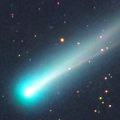
|
It was expected to be a great comet as it approached to the sun down to only 0.01 A.U. on Nov. 28. It brightened up to -2.5 mag at best. However, it rapidly faded out at the perihelion passage. It was 2-3 mag just after the perihelion passage (Nov. 29). In the Northern Hemisphere, it will appear in the morning sky again soon. It approaches to the earth down to 0.4 A.U. from mid December to early January, and it will be observable in excellent condition in the Northern Hemisphere. Probably the dust remnant will be visible around 8-9 mag. It is not observable in the Southern Hemisphere.
Date(TT) R.A. (2000) Decl. Delta r Elong. m1 Best Time(A, h)
Nov. 30 16 21.43 -16 21.2 0.913 0.114 5 3.2 5:19 (280,-15)
Dec. 7 16 12.14 -2 36.3 0.690 0.436 22 7.0 5:24 (275, 1)
|
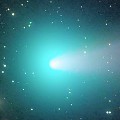
|
Now it is so bright as 4.3 mag (Nov. 28, Salvador Aguirre). It will pass only 0.4 A.U. from the earth, and 0.8 A.U. from the sun in November and December, and will brighten up to 4-5 mag. In the Northern Hemisphere, it keeps observable in excellent condition for a long time until 2014 autumn when the comet will fade out. In the Southern Hemisphere, it is not be observable from mid November to early February.
Date(TT) R.A. (2000) Decl. Delta r Elong. m1 Best Time(A, h)
Nov. 30 14 36.53 41 18.5 0.478 0.918 67 4.5 5:19 (241, 36)
Dec. 7 15 51.41 36 5.8 0.595 0.865 60 4.6 5:24 (243, 26)
|
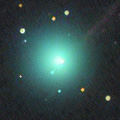
|
It brightened rapidly as expected. It passed the perihelion on Nov. 21, and brightened up to 7.8 mag (Nov. 18, Todd Augustyniak). It will never be observable after this.
Date(TT) R.A. (2000) Decl. Delta r Elong. m1 Best Time(A, h)
Nov. 30 15 37.51 -22 28.2 1.327 0.403 10 8.2 5:19 (291, -9)
Dec. 7 16 26.29 -25 48.8 1.482 0.519 7 9.2 5:24 (292,-14)
|
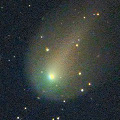
|
Although it was predicted to be 14 mag, it is extremely bright as 8.2 mag in outburst now (Nov. 12, Marek Biely). The dust shell is getting diffuse, and expanding up to 50x20 arcmin (Nov. 28, Michael Jager). It will be observable in excellent condition in 2014 spring. In the Northern Hemisphere, it will be getting higher gradually in the morning sky. In the Southern Hemisphere, it is not observable until 2014 February.
Date(TT) R.A. (2000) Decl. Delta r Elong. m1 Best Time(A, h)
Nov. 30 14 52.72 17 33.0 2.514 1.947 45 8.8 5:19 (264, 22)
Dec. 7 15 13.27 16 9.7 2.445 1.897 45 9.0 5:24 (267, 24)
|
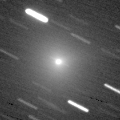
|
New bright comet. It brightened very rapidly after discovered on Nov. 6 at 15 mag. Now it is bright as 10.5 mag but diffuse (Nov. 30, Alan Hale). It seems to keep 10-11 mag for a while after this. It is observable in excellent condition in the Northern Hemisphere. It locates somewhat low in the Southern Hemisphere.
Date(TT) R.A. (2000) Decl. Delta r Elong. m1 Best Time(A, h)
Nov. 30 10 1.78 16 22.5 0.892 1.450 100 10.4 5:19 (355, 71)
Dec. 7 10 19.03 19 59.2 0.875 1.480 105 10.4 5:16 ( 0, 75)
|
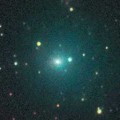
|
It brightened very rapidly. Now it is so bright as 10.1 mag (Nov. 27, Chris Wyatt). It keeps bright as 10 mag from autumn to winter. In the Northern Hemipshere, it keeps observable in excellent condition until the comet fades out. In the Southern Hemisphere, it keeps observable in good condition within 2013, but it will not be observable in 2014.
Date(TT) R.A. (2000) Decl. Delta r Elong. m1 Best Time(A, h)
Nov. 30 22 39.97 9 10.1 1.162 1.614 97 10.7 18:18 ( 8, 64)
Dec. 7 22 52.57 11 13.8 1.207 1.609 93 10.7 18:18 ( 18, 65)
|
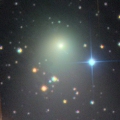
|
It became much brighter than expected, and reached up to 8.5 mag (Aug. 15, Alexandre Amorim). Now it is fading, but it is bright as 10.7 mag still now (Nov. 5, Alexandre Amorim). In the Southern Hemisphere, it will keep observable in good condition for a long time until 2014 summer when the comet fades out. It will never be observable again in the Northern Hemisphere.
Date(TT) R.A. (2000) Decl. Delta r Elong. m1 Best Time(A, h)
Nov. 30 13 16.54 -59 49.8 2.538 2.055 50 11.9 5:19 (337,-14)
Dec. 7 13 42.71 -61 28.9 2.601 2.119 50 12.2 5:24 (338,-14)
|
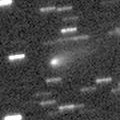
|
First return of a new periodic comet discovered in 1998. It brightened up to 10 mag at the discovery. Now it is 14.0 mag (Nov. 27, Sandor Szabo). In the Northern Hemisphere, it keeps observable in excellent condition from autumn to spring. A bit fainter than originally expected, but it will brighten up to 13 mag. It locates somewhat low in the Southern Hemisphere.
Date(TT) R.A. (2000) Decl. Delta r Elong. m1 Best Time(A, h)
Nov. 30 6 53.41 41 21.3 1.495 2.358 142 13.2 2:19 (180, 84)
Dec. 7 6 50.71 40 59.2 1.431 2.333 149 13.0 1:49 (180, 84)
|
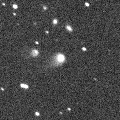
|
Now it is 14.0 mag and visible visually (Sept. 6, Sandor Szabo). It is expected to brighten up to 5-6 mag in 2014 autumn. In the Northern Hemisphere, it keeps observable in good condition for a long time, although it will be unobservable temporarily in late November. In the Southern Hemisphere, it will not be observable until 2014 February.
Date(TT) R.A. (2000) Decl. Delta r Elong. m1 Best Time(A, h)
Nov. 30 16 2.40 10 12.1 4.623 3.825 32 13.2 5:19 (260, 4)
Dec. 7 16 6.34 10 7.0 4.519 3.751 34 13.0 5:24 (265, 10)
|
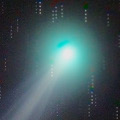
|
It approached to the sun down to 0.73 A.U. on Mar. 24, and brightened up to 4.7 mag (Mar. 11, Michael Mattiazzo). Now it is fading. It has already faded down to 14.0 mag (Nov. 27, Sandor Szabo). In the Northern Hemisphere, it keeps observable in good condition while fading gradually. In the Southern Hemisphere, it will never be observable again.
Date(TT) R.A. (2000) Decl. Delta r Elong. m1 Best Time(A, h)
Nov. 30 19 17.73 49 6.2 3.805 3.771 80 13.6 18:18 (127, 48)
Dec. 7 19 25.24 48 47.3 3.916 3.850 78 13.7 18:18 (127, 45)
|
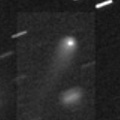
|
Now it is 13.5 mag and visible visually (Nov. 27, Sandor Szabo). It keeps 13-14 mag and observable in good condition in the Northern Hemisphere for a long time from 2013 to 2014. In the Southern Hemisphere, it is not observable until 2014 autumn.
Date(TT) R.A. (2000) Decl. Delta r Elong. m1 Best Time(A, h)
Nov. 30 13 33.37 80 44.3 3.067 3.451 104 13.7 5:19 (190, 40)
Dec. 7 15 1.83 83 18.3 3.034 3.448 106 13.6 5:24 (188, 37)
|

|
Now it is 12.9 mag (Nov. 27, Sandor Szabo). It keeps bright at 13-14 mag for a long time until 2014. It keeps observable for a long time in the Northern Hemisphere. It locates somewhat low in the Southern Hemisphere.
Date(TT) R.A. (2000) Decl. Delta r Elong. m1 Best Time(A, h)
Nov. 30 19 21.57 8 51.1 6.596 6.057 53 13.8 18:18 ( 75, 35)
Dec. 7 19 23.76 8 7.9 6.686 6.068 47 13.9 18:18 ( 79, 29)
|

|
It brightened up to 11-12 mag in 2012. Now it is bright as 13.7 mag (July 24, Taras Prystavski). In the Northern Hemisphere, it is appearing in the morning sky again. In the Southern Hemisphere, it will be observable again after mid December.
Date(TT) R.A. (2000) Decl. Delta r Elong. m1 Best Time(A, h)
Nov. 30 13 29.49 -13 42.4 7.453 6.754 42 14.0 5:19 (304, 19)
Dec. 7 13 30.04 -13 55.6 7.391 6.786 49 14.0 5:24 (310, 25)
|

|
Not observable now. It will appear in the morning sky again in late December.
Date(TT) R.A. (2000) Decl. Delta r Elong. m1 Best Time(A, h)
Nov. 30 15 4.62 -25 47.6 7.107 6.180 18 14.2 5:19 (298, -5)
Dec. 7 15 10.19 -26 11.5 7.067 6.179 23 14.2 5:24 (302, -1)
|
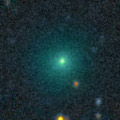
|
Now it is 14.6 mag (Nov. 22, Toshiyuki Takahashi). It will be fading slowly until May when it becomes fainter than 18 mag. It keeps observable in good condition in the Southern Hemisphere. It keeps locating extremely low in the Northern Hemisphere.
Date(TT) R.A. (2000) Decl. Delta r Elong. m1 Best Time(A, h)
Nov. 30 12 40.96 -23 3.3 2.363 1.908 51 14.4 5:19 (319, 20)
Dec. 7 12 50.30 -25 58.3 2.371 1.982 55 14.6 5:24 (326, 20)
|

|
Big asteroid discovered in 1906. It suddenly showed the cometary activity on Dec. 11, 2010, probably due to an impact of a small object. It has already turned to be stellar.
Date(TT) R.A. (2000) Decl. Delta r Elong. m1 Best Time(A, h)
Nov. 30 0 9.51 -14 43.2 2.713 3.158 107 14.5 19:32 ( 0, 40)
Dec. 7 0 10.90 -13 48.8 2.817 3.168 101 14.6 19:06 ( 0, 41)
|
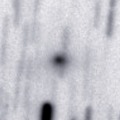
|
It brightened up to 2 mag by unusual major outburst in 2007. It will return in 2014. It will be 14 mag at best by normal prediction. But actually, it is already very bright as 13.5 mag (Nov. 25, Hidetaka Sato). It will be unobservable soon, and keeps unobservable until May.
Date(TT) R.A. (2000) Decl. Delta r Elong. m1 Best Time(A, h)
Nov. 30 19 32.49 -26 45.8 2.865 2.249 43 14.6 18:18 ( 45, 12)
Dec. 7 19 46.98 -25 31.7 2.900 2.228 39 14.5 18:18 ( 48, 11)
|

|
Now it is 14.1 mag and visible visually (Nov. 27, Sandor Szabo). It keeps 14 mag for a long time until 2014 summer. It keeps observable in good condition in the Northern Hemisphere. It is observable only until February in the Southern Hemisphere.
Date(TT) R.A. (2000) Decl. Delta r Elong. m1 Best Time(A, h)
Nov. 30 4 17.96 -10 46.5 1.563 2.454 147 14.9 23:38 ( 0, 44)
Dec. 7 4 3.39 -8 32.7 1.509 2.393 146 14.7 22:56 ( 0, 47)
|
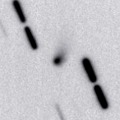
|
Now it is 15.2 mag (Nov. 23, K. Hills). It is expected to brighten up to 7.5 mag and to be observable in excellent condition from summer to autumn in 2014 in the Southern Hemisphere. The condition is bad in the Northern Hemisphere. It will pass extremely close to Mars in 2014 October.
Date(TT) R.A. (2000) Decl. Delta r Elong. m1 Best Time(A, h)
Nov. 30 4 26.46 -38 19.6 3.703 4.283 120 14.9 23:47 ( 0, 17)
Dec. 7 4 13.67 -38 57.3 3.666 4.215 117 14.8 23:07 ( 0, 16)
|
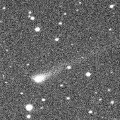
|
It keeps bright as 13-14 mag for a long time from 2013 to 2014. Now it is not observable. But it will appear in the morning sky again in 2014 February.
Date(TT) R.A. (2000) Decl. Delta r Elong. m1 Best Time(A, h)
Nov. 30 16 54.37 -24 43.1 4.085 3.110 7 14.9 18:18 ( 69,-14)
Dec. 7 17 6.40 -25 8.7 4.087 3.104 3 14.9 18:18 ( 71,-17)
|
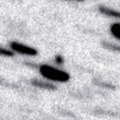
|
It reaches up to 12 mag in 2014 spring. But the condition in this apparition is bad. It locates low around the brightest days. Now it is 15.4 mag (Nov. 24, A. Klotz, F. Kugel, J. Nicolas). It keeps observable in good condition until winter when the comet will brighten up to 15-16 mag.
Date(TT) R.A. (2000) Decl. Delta r Elong. m1 Best Time(A, h)
Nov. 30 20 18.58 -13 6.0 2.772 2.372 56 15.6 18:18 ( 45, 29)
Dec. 7 20 30.06 -12 46.0 2.803 2.330 52 15.5 18:18 ( 48, 27)
|
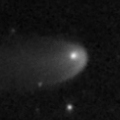
|
Now it is 15.5 mag (Nov. 18, Yasukazu Ikari). It keeps 15 mag and observable in good condition in 2013. It locates somewhat low in the Northern Hemisphere.
Date(TT) R.A. (2000) Decl. Delta r Elong. m1 Best Time(A, h)
Nov. 30 3 27.29 -24 40.1 6.704 7.397 131 15.5 22:49 ( 0, 30)
Dec. 7 3 23.03 -24 8.9 6.778 7.429 128 15.5 22:17 ( 0, 31)
|
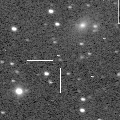
|
It is expected to brighten up to 13 mag and to be observable in excellent condition from spring to summer in 2014. Appearing in the morning sky. It has not been observed since May. But it must be already brightening up to 16 mag.
Date(TT) R.A. (2000) Decl. Delta r Elong. m1 Best Time(A, h)
Nov. 30 12 33.21 -5 35.7 3.325 2.923 57 15.8 5:19 (309, 35)
Dec. 7 12 42.82 -6 33.3 3.218 2.898 62 15.6 5:24 (316, 38)
|
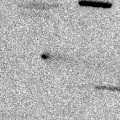
|
Now it is 16.6 mag (Nov. 8, Toshiyuki Takahashi). It tends to be brightest 4 months after the perihelion passage. It will reach up to 15.5 mag from autumn to winter, and will be observable in excellent condition.
Date(TT) R.A. (2000) Decl. Delta r Elong. m1 Best Time(A, h)
Nov. 30 6 37.13 17 23.5 1.252 2.155 148 15.6 2:03 ( 0, 72)
Dec. 7 6 32.19 17 50.4 1.246 2.185 156 15.6 1:30 ( 0, 73)
|
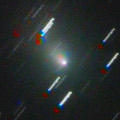
|
It brightened up to 9-10 mag in 2013 spring. Now it is fading. It has already faded down to 15.8 mag (Oct. 7, Hidetaka Sato). In the Southern Hemisphere, it keeps observable for a long time until the comet fades out, although it keeps locating low. It will never be observable again in the Northern Hemisphere.
Date(TT) R.A. (2000) Decl. Delta r Elong. m1 Best Time(A, h)
Nov. 30 14 38.80 -63 25.0 3.639 3.029 45 15.8 5:19 (333,-23)
Dec. 7 15 0.14 -64 2.6 3.708 3.098 45 16.0 5:24 (334,-23)
|
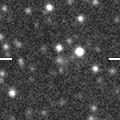
|
Now it is 16.8 mag (Nov. 2, J. F. Hernandez). It will brighten rapidly and will be observable at 15 mag in winter in excellent condition in the Northern Hemisphere. It locates low in the Southern Hemisphere.
Date(TT) R.A. (2000) Decl. Delta r Elong. m1 Best Time(A, h)
Nov. 30 4 28.19 41 55.6 1.038 1.992 159 16.1 23:50 (180, 83)
Dec. 7 4 21.67 41 53.4 1.011 1.964 159 15.9 23:16 (180, 83)
|

|
It brightened up to 12 mag in 2012. It is bright as 14.1 mag still now (Oct. 27, Hidetaka Sato). It will be fading and getting lower after this, and will be unobservable at 17 mag in December.
Date(TT) R.A. (2000) Decl. Delta r Elong. m1 Best Time(A, h)
Nov. 30 20 33.70 -31 14.3 3.732 3.285 56 16.4 18:18 ( 31, 16)
Dec. 7 20 43.52 -30 34.5 3.825 3.301 51 16.5 18:18 ( 35, 15)
|

|
It brightened up to 12-13 mag from autumn to winter in 2012. Now it is fading. It has already faded down to 16.3 mag (Nov. 24, J. Gonzalez). It keeps observable for a long time until March when the comet becomes fainter than 18 mag.
Date(TT) R.A. (2000) Decl. Delta r Elong. m1 Best Time(A, h)
Nov. 30 6 1.87 -0 4.0 3.728 4.593 147 16.5 1:27 ( 0, 55)
Dec. 7 5 58.13 -0 42.4 3.744 4.637 151 16.5 0:56 ( 0, 54)
|

|
It approached to the sun down to 0.14 A.U. on Oct. 7. In the Northern Hemisphere, it keeps observable at 16 mag in good condition from late October to mid December. In the Southern Hemisphere, it locates very low from November to December.
Date(TT) R.A. (2000) Decl. Delta r Elong. m1 Best Time(A, h)
Nov. 30 21 11.11 11 11.6 0.960 1.221 77 16.6 18:18 ( 51, 57)
Dec. 7 21 42.04 11 54.7 1.093 1.316 78 16.9 18:18 ( 50, 58)
|

|
Brightened rapidly. Now it is visible visually at 15.6 mag (Nov. 27, Sandor Szabo). It keeps observable in excellent condition until autumn. Some visual observers reported it extremely bright as 12 mag in August.
Date(TT) R.A. (2000) Decl. Delta r Elong. m1 Best Time(A, h)
Nov. 30 22 15.76 7 6.6 2.110 2.341 90 16.6 18:18 ( 20, 61)
Dec. 7 22 26.44 7 42.7 2.211 2.367 86 16.8 18:18 ( 29, 60)
|
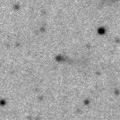
|
Now it is 17.5 mag (Nov. 22, K. Hills). It keeps 17 mag for a long time from 2013 summer to early 2015.
Date(TT) R.A. (2000) Decl. Delta r Elong. m1 Best Time(A, h)
Nov. 30 1 38.84 13 25.6 2.276 3.097 139 16.7 21:01 ( 0, 68)
Dec. 7 1 37.84 13 4.5 2.337 3.089 132 16.7 20:32 ( 0, 68)
|

|
Now it is 16.8 mag (Nov. 6, G. Borisov, O. Bryzgalov). It keeps 16 mag for a long time until 2015 summer. It keeps observable in good condition in the Northern Hemisphere. It becomes observable only after 2015 in the Southern Hemisphere.
Date(TT) R.A. (2000) Decl. Delta r Elong. m1 Best Time(A, h)
Nov. 30 5 24.70 51 3.7 3.660 4.529 148 16.9 0:51 (180, 74)
Dec. 7 5 18.57 51 47.4 3.608 4.491 150 16.8 0:17 (180, 73)
|
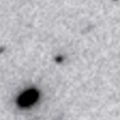
|
It is expected to brighten up to 13 mag and to be observable in good condition in 2015. Now appearing in the morning sky. In 2014, it will be observable at 15 mag in good condition from winter to summer.
Date(TT) R.A. (2000) Decl. Delta r Elong. m1 Best Time(A, h)
Nov. 30 13 21.55 -3 22.8 6.156 5.542 47 16.9 5:19 (297, 28)
Dec. 7 13 26.65 -3 43.2 6.025 5.498 53 16.8 5:24 (303, 33)
|
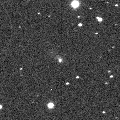
|
It brightened up to 14.0 mag from spring to summer (June 11, Sandor Szabo). Now it is fading. It will be observable at 17-18 mag from winter to spring. It locates somewhat low in the Southern Hemisphere.
Date(TT) R.A. (2000) Decl. Delta r Elong. m1 Best Time(A, h)
Nov. 30 13 44.92 1 16.0 4.432 3.800 45 16.9 5:19 (289, 27)
Dec. 7 13 47.38 2 6.8 4.361 3.830 51 16.9 5:24 (294, 33)
|
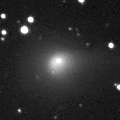
|
Fading slowly. It is bright as 16.3 mag still now (Nov. 24, Y. Sugiyama). It keeps observable in good condition until the comet will be fainter than 18 mag in January.
Date(TT) R.A. (2000) Decl. Delta r Elong. m1 Best Time(A, h)
Nov. 30 0 36.44 -5 4.3 3.072 3.644 118 16.9 19:59 ( 0, 50)
Dec. 7 0 37.56 -5 1.9 3.237 3.714 111 17.1 19:32 ( 0, 50)
|
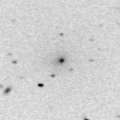
|
It brightened rapidly, and it keeps bright as 15.9 mag still now (Nov. 25, A. Maury, J.-F Soulier, J. G Bosch). It will be fading after this. But it may keep 16 mag some more time. It will be getting higher gradually in the Southern Hemisphere. But it keeps locating extremely low in the Northern Hemisphere.
Date(TT) R.A. (2000) Decl. Delta r Elong. m1 Best Time(A, h)
Nov. 30 9 55.35 -48 44.4 2.546 2.539 78 17.0 5:19 ( 0, 6)
Dec. 7 9 35.56 -50 48.2 2.493 2.587 84 17.2 4:33 ( 0, 4)
|
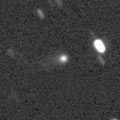
|
It was observed at 15-16 mag in 2012. Now it is fading slowly. But it keeps 16.8 mag still now (Nov. 24, Y. Sugiyama). It will be fainter than 18 mag in January. It locates low in the Southern Hemisphere.
Date(TT) R.A. (2000) Decl. Delta r Elong. m1 Best Time(A, h)
Nov. 30 0 15.06 15 35.6 4.352 4.935 121 17.0 19:37 ( 0, 71)
Dec. 7 0 12.57 14 14.0 4.504 4.976 113 17.2 19:07 ( 0, 69)
|
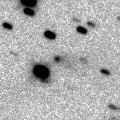
|
Now it is 16.5 mag (Nov. 22, Y. Sugiyama). It will be observable at 17 mag in excellent condition from autumn to winter.
Date(TT) R.A. (2000) Decl. Delta r Elong. m1 Best Time(A, h)
Nov. 30 2 44.36 17 18.7 1.660 2.593 156 17.1 22:06 ( 0, 72)
Dec. 7 2 42.02 16 46.5 1.700 2.592 148 17.2 21:36 ( 0, 72)
|
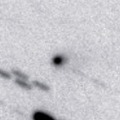
|
First return of a new periodic comet discovered in 1998. Now it is 16.3 mag (Nov. 23, Y. Sugiyama). It is fainter than originally expected by 1-2 mag. It was expected to be observable at 15 mag in good condition from 2013 autumn to early 2014. But actually, it will be 17 mag at best.
Date(TT) R.A. (2000) Decl. Delta r Elong. m1 Best Time(A, h)
Nov. 30 1 35.67 -21 14.6 1.936 2.582 120 17.2 20:58 ( 0, 34)
Dec. 7 1 35.21 -19 35.7 1.986 2.571 115 17.2 20:30 ( 0, 36)
|
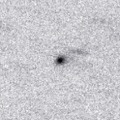
|
Now it is 17.5 mag (Nov. 24, Y. Sugiyama). Brighter than origianlly predicted. It will be observable at 12-13 mag in excellent condition from 2014 summer to 2015 spring. In the Southern Hemisphere, it will locate low around the highlight.
Date(TT) R.A. (2000) Decl. Delta r Elong. m1 Best Time(A, h)
Nov. 30 0 11.94 -7 17.8 2.795 3.292 111 17.3 19:34 ( 0, 48)
Dec. 7 0 12.24 -6 48.0 2.855 3.254 105 17.2 19:07 ( 0, 48)
|

|
Now it is 18.6 mag (Oct. 13, Ken-ichi Kadota). It will brighten up to 14 mag around the perihelion passage in 2019. In 2013, it will be observable in good condition at 18 mag from summer to winter. It locates low in the Southern Hemisphere.
Date(TT) R.A. (2000) Decl. Delta r Elong. m1 Best Time(A, h)
Nov. 30 2 50.75 27 10.4 12.756 13.676 158 17.4 22:13 ( 0, 82)
Dec. 7 2 48.85 27 8.4 12.776 13.648 151 17.4 21:43 ( 0, 82)
|
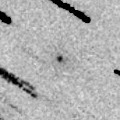
|
Although it had been fainter than expected, it is brightening now. Probably it tends to be brightest after the perihelion passage. Now it is 18.0 mag (Nov. 23, R. Naves, M. Campas). It keeps observable at 17-18 mag until December. It locates somewhat low in the Southern Hemisphere.
Date(TT) R.A. (2000) Decl. Delta r Elong. m1 Best Time(A, h)
Nov. 30 4 47.15 23 50.8 0.945 1.929 174 17.4 0:13 ( 0, 79)
Dec. 7 4 39.45 23 26.8 0.992 1.976 176 17.6 23:33 ( 0, 78)
|

|
It keeps 15-16 mag for a long time from 2015 to 2016. In this winter, it is observable at 17.5 mag until March.
Date(TT) R.A. (2000) Decl. Delta r Elong. m1 Best Time(A, h)
Nov. 30 3 10.81 -7 24.9 6.331 7.169 145 17.6 22:32 ( 0, 48)
Dec. 7 3 7.06 -7 1.6 6.348 7.135 140 17.5 22:01 ( 0, 48)
|
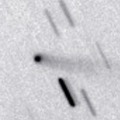
|
Now it is 16.9 mag (Nov. 24, A. Klotz, F. Kugel, J. Nicolas). It will be fading after this, and will be fainter than 18 mag in late December.
Date(TT) R.A. (2000) Decl. Delta r Elong. m1 Best Time(A, h)
Nov. 30 0 20.45 3 7.1 1.892 2.513 118 17.6 19:43 ( 0, 58)
Dec. 7 0 25.24 2 41.5 2.000 2.539 112 17.8 19:20 ( 0, 58)
|
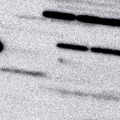
|
Now it is 17.6 mag (Nov. 24, G. Hug). It keeps observable at 17.5 mag in good condition from autumn to winter.
Date(TT) R.A. (2000) Decl. Delta r Elong. m1 Best Time(A, h)
Nov. 30 7 29.81 18 40.2 1.392 2.213 136 17.7 2:55 ( 0, 74)
Dec. 7 7 27.33 19 23.5 1.366 2.240 144 17.7 2:25 ( 0, 74)
|
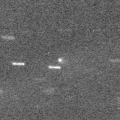
|
It was recovered in 2012, and observed at 19 mag. In this winter, it is observable at 17.5 mag in good condition until March.
Date(TT) R.A. (2000) Decl. Delta r Elong. m1 Best Time(A, h)
Nov. 30 10 35.01 12 14.2 2.157 2.402 91 18.0 5:19 (335, 65)
Dec. 7 10 41.74 11 36.9 2.082 2.413 97 17.9 5:24 (351, 66)
|
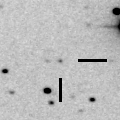
|
Now it is 18.6 mag (Nov. 24, A. Maury, J.-F Soulier, J. G Bosch). It keeps 18-19 mag for a long time until 2015. It is observable at 18 mag in good condition in this winter.
Date(TT) R.A. (2000) Decl. Delta r Elong. m1 Best Time(A, h)
Nov. 30 6 21.46 11 55.4 6.730 7.603 150 17.9 1:47 ( 0, 67)
Dec. 7 6 16.36 11 25.8 6.683 7.603 157 17.9 1:14 ( 0, 66)
|
|
![]()
 C/2013 A1 ( Siding Spring )
C/2013 A1 ( Siding Spring ) 117P/Helin-Roman-Alu 1
117P/Helin-Roman-Alu 1 4P/Faye
4P/Faye C/2009 F4 ( McNaught )
C/2009 F4 ( McNaught ) 134P/Kowal-Vavrova
134P/Kowal-Vavrova 84P/Giclas
84P/Giclas C/2012 L2 ( LINEAR )
C/2012 L2 ( LINEAR ) 52P/Harrington-Abell
52P/Harrington-Abell 246P/2010 V2 ( NEAT )
246P/2010 V2 ( NEAT ) C/2012 J1 ( Catalina )
C/2012 J1 ( Catalina ) (3200) Phaethon
(3200) Phaethon P/2013 J2 ( McNaught )
P/2013 J2 ( McNaught ) 119P/Parker-Hartley
119P/Parker-Hartley C/2013 V2 ( Borisov )
C/2013 V2 ( Borisov ) C/2012 F3 ( PanSTARRS )
C/2012 F3 ( PanSTARRS ) C/2012 K6 ( McNaught )
C/2012 K6 ( McNaught ) C/2013 E2 ( Iwamoto )
C/2013 E2 ( Iwamoto ) C/2013 G6 ( Lemmon )
C/2013 G6 ( Lemmon ) C/2012 A2 ( LINEAR )
C/2012 A2 ( LINEAR ) 291P/2013 N2 ( NEAT )
291P/2013 N2 ( NEAT ) 292P/2013 O1 ( Li )
292P/2013 O1 ( Li ) 32P/Comas Sola
32P/Comas Sola C/2010 U3 ( Boattini )
C/2010 U3 ( Boattini ) 184P/Lovas 2
184P/Lovas 2 C/2013 V4 ( Catalina )
C/2013 V4 ( Catalina ) 257P/2012 F4 ( Catalina )
257P/2012 F4 ( Catalina ) 178P/Hug-Bell
178P/Hug-Bell 266P/2012 P1 ( Christensen )
266P/2012 P1 ( Christensen ) C/2012 A1 ( PanSTARRS )
C/2012 A1 ( PanSTARRS )![]()










































